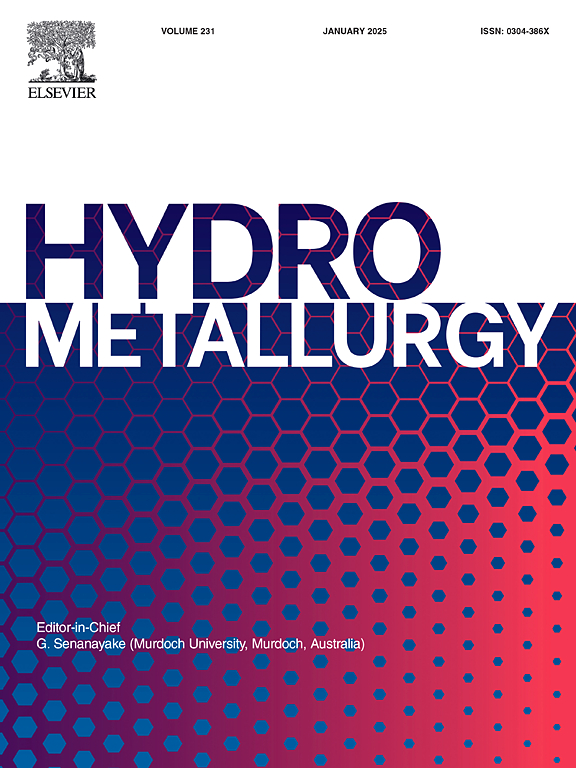载载功能化深度共熔溶剂的XAD-2树脂吸附废水中贵金属的研究
IF 4.8
2区 材料科学
Q1 METALLURGY & METALLURGICAL ENGINEERING
引用次数: 0
摘要
本研究采用季铵疏水深共晶溶剂(HDES)浸渍XAD-2树脂,制备了吸附速率快的新型吸附材料XAD-2-HDES。将其应用于王水溶液中各种贵金属离子的富集和回收。结果表明:在三辛甲基氯化铵(N263)与薄荷醇(Men)摩尔比为1:2、吸附剂用量为20 g L−1、初始水相pH为0.1、吸附时间为2 h、吸附温度为298.15 K的条件下,Ir(IV)、Pt(IV)、Ru(III)和Rh(III)的吸附效率分别为95.3%、99.8%、94.1%和43.9%。在最佳工艺条件下,Ir(IV)、Pt(IV)、Ru(III)和Rh(III)的最大负载分别为19.4 mg g−1、20.6 mg g−1、4.6 mg g−1和4.3 mg g−1。贵金属离子的吸附过程服从Langmuir模型和准二级动力学模型,主要受单分子层的化学反应控制。XAD-2-HDES的表面负载HDES提供了丰富的吸附反应位点,吸附过程主要由静电吸引驱动。贵金属络合物离子在N263中与Cl−发生阴离子交换反应,以N原子为桥梁通过配体键与HDES形成稳定的疏水型中性络合物,并与Men的-OH基团形成新的氢键网络,促进络合物的溶解。本文章由计算机程序翻译,如有差异,请以英文原文为准。
Study on the adsorption of precious metals from wastewater by XAD-2 resin loaded with functionalized deep eutectic solvent
This study prepared a novel adsorption material XAD-2-HDES with fast adsorption rate by impregnating XAD-2 resin with quaternary ammonium hydrophobic deep eutectic solvent (HDES). It was applied to the enrichment and recovery of various precious metal ions in aqua regia solution. The results showed that the adsorption efficiencies of Ir(IV), Pt(IV), Ru(III) and Rh(III) were 95.3 %, 99.8 %, 94.1 % and 43.9 %, respectively, under the following conditions: trioctylmethylammonium chloride (N263) to menthol (Men) molar ratio of 1:2, adsorbent dosage of 20 g L−1, initial aqueous phase pH of 0.1, adsorption time of 2 h, and adsorption temperature of 298.15 K. Under optimal process conditions, the maximum loading of Ir(IV), Pt(IV), Ru(III), and Rh(III) were 19.4 mg g−1, 20.6 mg g−1, 4.6 mg g−1 and 4.3 mg g−1, respectively. The adsorption process of precious metal ions obeys the Langmuir model and quasi-second-order kinetic model, which is mainly controlled by the chemical reaction of the monomolecular layer. The surface loaded HDES of XAD-2-HDES provides abundant adsorption reaction sites, and the adsorption process is mainly driven by electrostatic attraction. The complex ions of precious metals undergo an anion-exchange reaction with Cl− in N263 to form a stable hydrophobic type neutral complex species with N atoms as a bridge with HDES through ligand bonding, and form a new hydrogen-bonding network with the –OH group of Men to facilitate the dissolution of the complex.
求助全文
通过发布文献求助,成功后即可免费获取论文全文。
去求助
来源期刊

Hydrometallurgy
工程技术-冶金工程
CiteScore
9.50
自引率
6.40%
发文量
144
审稿时长
3.4 months
期刊介绍:
Hydrometallurgy aims to compile studies on novel processes, process design, chemistry, modelling, control, economics and interfaces between unit operations, and to provide a forum for discussions on case histories and operational difficulties.
Topics covered include: leaching of metal values by chemical reagents or bacterial action at ambient or elevated pressures and temperatures; separation of solids from leach liquors; removal of impurities and recovery of metal values by precipitation, ion exchange, solvent extraction, gaseous reduction, cementation, electro-winning and electro-refining; pre-treatment of ores by roasting or chemical treatments such as halogenation or reduction; recycling of reagents and treatment of effluents.
 求助内容:
求助内容: 应助结果提醒方式:
应助结果提醒方式:


